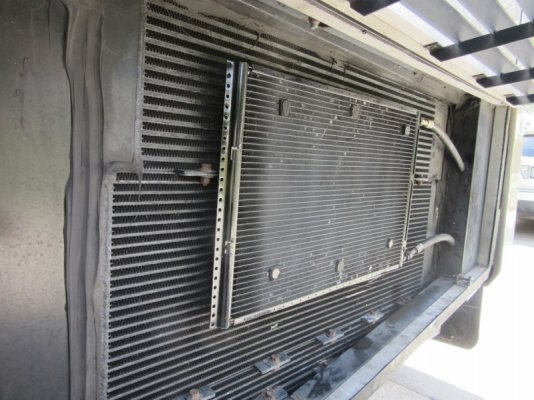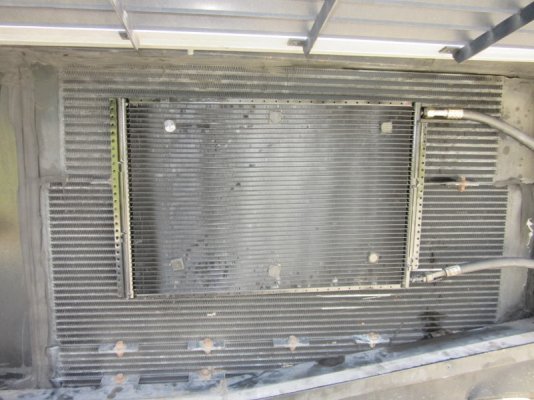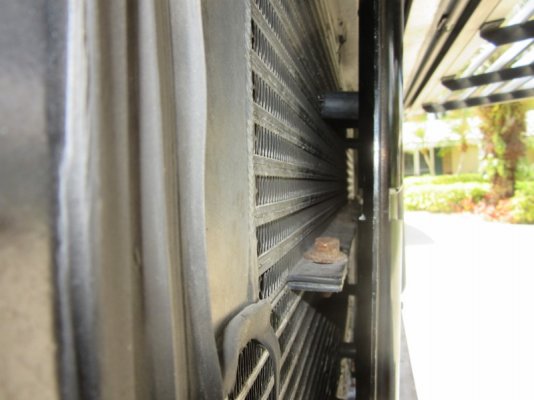I would like some opinions from those in the know about a dash air conditioning repair that has altered (in my opinion) the cooling design of my Cummins ISL, Spartan Chassis, '07 American Tradition with side radiator.
The cooling system as designed by Spartan consists of a radiator stack with the intercooler radiator on top followed by the engine cooling radiator, followed by the hydraulic cooling radiator (steering & fan motor) and on the bottom of the stack the air conditioning condenser.
The dash air conditioner repair shop determined the existing air conditioning condenser was faulty and in an attempt to save me some money and time decided to add an off the shelf air conditioner condenser to the back side of the cooling radiator stack which covers about 50% of the intercooler radiator and about 50% of the engine cooling radiator. They installed it with about an inch or so space between the stack and the new condenser. So airflow across the radiator stack flows from the fan through the radiator stack and then with about an inch space through the air conditioner condenser.
My concern is the airflow through the intercooler and engine cooling radiator will not be sufficient when the engine is under a heavy load, like climbing a 8% grade at 8000 ft. I called Spartan and explained the new installation to them and they could offer me no opinion as to this new installation saying only that if the cooling system is altered they could not say it will work properly. I was not talking to a cooling expert just a general tech. The dash air shop is telling me they have experience in this and the new install is OK.
I'm going to try attaching some pictures of the new install. The original condenser was left in place and the Freon lines rerouted to the new condenser. The original condenser is hard to see in the pictures but is the bottom most radiator. Each of the 4 radiators in the stack has the attachment bolts clearly seen in the pictures.
I would really appreciate some opinions on this new installation as it could save me a ton of money and is more efficient for the air conditioner but I do not want to affect the cooling to the engine or intercooler.
Sorry if you saw this elsewhere I'm trying to get as much exposure as possible.
The cooling system as designed by Spartan consists of a radiator stack with the intercooler radiator on top followed by the engine cooling radiator, followed by the hydraulic cooling radiator (steering & fan motor) and on the bottom of the stack the air conditioning condenser.
The dash air conditioner repair shop determined the existing air conditioning condenser was faulty and in an attempt to save me some money and time decided to add an off the shelf air conditioner condenser to the back side of the cooling radiator stack which covers about 50% of the intercooler radiator and about 50% of the engine cooling radiator. They installed it with about an inch or so space between the stack and the new condenser. So airflow across the radiator stack flows from the fan through the radiator stack and then with about an inch space through the air conditioner condenser.
My concern is the airflow through the intercooler and engine cooling radiator will not be sufficient when the engine is under a heavy load, like climbing a 8% grade at 8000 ft. I called Spartan and explained the new installation to them and they could offer me no opinion as to this new installation saying only that if the cooling system is altered they could not say it will work properly. I was not talking to a cooling expert just a general tech. The dash air shop is telling me they have experience in this and the new install is OK.
I'm going to try attaching some pictures of the new install. The original condenser was left in place and the Freon lines rerouted to the new condenser. The original condenser is hard to see in the pictures but is the bottom most radiator. Each of the 4 radiators in the stack has the attachment bolts clearly seen in the pictures.
I would really appreciate some opinions on this new installation as it could save me a ton of money and is more efficient for the air conditioner but I do not want to affect the cooling to the engine or intercooler.
Sorry if you saw this elsewhere I'm trying to get as much exposure as possible.



